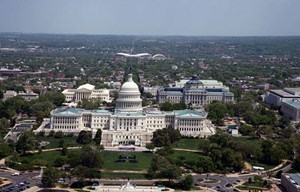U.S. midterm elections have significant implications for the oil and gas industry
The 2022 U.S. midterm elections will be held on Nov. 8, 2022. All 435 seats in the House of Representatives and 35 of the 100 seats in the Senate are contested. Thirty-nine state gubernatorial and numerous other state and local elections are also contested. This will be the first election affected by the redistricting that followed the 2020 census. The Republicans are favored to retake a majority in the House, but control of the Senate remains a “tossup.”
THE ISSUES
Until several months ago, Republicans were strongly favored to retake control of both the House and Senate. However, in June, the Supreme Court overturned Roe v. Wade, which for 50 years had made abortion legal in the U.S. The Court’s decision immediately made abortion access a state issue. Numerous Republican-controlled states quickly moved to criminalize abortion or severely restrict access, and the Court’s decision changed the election dynamics: 52% of voters say they strongly opposed the Court’s ruling while 19% say they strongly supported it. And only 40% percent of Republicans support a near-total abortion ban.
Since the Court’s ruling, Democrats have outperformed Biden’s 2020 results in several House special elections, including Alaska where Sara Palin—the 2008 Republican Vice Presidential nominee—was defeated. In August, reliably Republican Kansas voted 59% to 41%, to maintain abortion access. In November, six states have an abortion-related ballot initiative, the most ever in a single year.
The Russian invasion of Ukraine is a major issue, favoring President Biden. Since Biden’s recent plan for student loan forgiveness, both parties are seeking advantage from the decision, with Republicans targeting blue-collar workers and Democrats targeting young voters. Recent mass shootings have made gun violence important for Democratic and independent voters. In addition, the price of gasoline decreased for 98 straight days beginning June 14, which also helps Biden and the Democrats.
Nevertheless, fundamentals issues—inflation, the economy, and an unpopular president—favor the Republicans. The national mood, while more optimistic than earlier in 2022, remains gloomy. Republicans score higher on some social issues, including illegal immigration. And the president’s approval rating is only 42%—as weak as the ratings of every president whose party lost control of Congress in mid-term elections since 1978. The Republicans’ challenge is to focus voters on the economy and inflation.
WHAT IS AT STAKE
There is much at stake in these elections for the O&G industry, Fig. 1. Since Jan. 20, 2021, the Biden Administration has waged an unremitting (although uneven) war against the industry and is promising more of the same for the next two years. It is thus essential for the O&G industry that Republicans regain control of at least the House or the Senate to halt or reverse numerous deleterious policies.

The Biden Administration’s energy policy is contradictory. Campaigning in 2020, Biden promised to “end fossil fuels” and pledged “No more drilling on federal lands, no more drilling, including offshore—no ability for the oil industry to continue to drill—period.” Accordingly, the administration has been assailing U.S. O&G producers. Biden cancelled the Keystone XL Pipeline, placed a moratorium on new O&G leases on federal lands, and slow-walked permits for natural gas projects.
However, when gasoline prices more than doubled, and inflation reached a 40-year high, Biden was reduced to begging Saudi Arabia, Venezuela and Iran to produce more oil. At the same time, the administration claims (unconvincingly) to be doing all it can to increase O&G production, and DOE Secretary Granholm stated, “we need to have increased production, so that everyday citizens in America will not be feeling this pain that they’re feeling right now.”
The Interior Department has awarded 203 leases for O&G development during Biden’s first 19 months in office. Former presidents Trump and Obama each approved 10 times as many leases during the same period. The 203 leases under Biden total 3.2% of what presidents from Eisenhower to Trump awarded, on average, in the same span.
In June, Biden chastised oil companies for profiteering off surging energy prices and “worsening that pain” for consumers, and he increased pressure on them to increase refining capacity to reduce prices. In a letter to oil executives, he demanded they explain their decision to limit refining capacity and stated, “At a time of war, refinery profit margins well above normal being passed directly onto American families are not acceptable.” He claimed that oil companies were making billions in profits and deflected responsibility from his administration: “Since the beginning of the year, refiners’ margins for refining gasoline and diesel have tripled, and are currently at their highest levels ever recorded.”
THE IRA
The (misnamed) Inflation Reduction Act of 2022 (IRA) is expected to raise $737 billion and require investments of $437 billion. However, contrary to Economics Nobel Laurate and New York Times columnist Paul Krugman, it will not “save civilization.” With respect to IRA energy provisions, most attention has focused on massive subsidies for wind, solar, and electric vehicles. The tax provisions of the IRA have received less attention, but are similarly perverse.
First, the Hazardous Substance Superfund Financing tax on crude oil and petroleum products was reinstated. This tax of 16.4¢/bbl will cost producers $1.2 billion/yr., an outcome inconsistent with expanding production.
Second, the IRA imposes two new taxes on methane emissions from O&G production: per-metric ton fees ($900 in 2024, rising to $1,500 in 2026) for methane emissions exceeding 0.2% of natural gas sold from a facility or 10 metric tons of methane/MMbbl of oil produced. The taxes cannot satisfy any plausible benefit/cost test; rather, they are a revenue measure, with little economic or environmental justification. Moreover, they create conflicting political incentives: Increased methane emissions yield increased federal revenue and thus provide a disincentive to policies that facilitate modernization of the energy infrastructure, and thus reduce emissions.
Third, the IRA increases the royalty rate for O&G leases on federal lands and the OCS from 12.5% to 16.67%, increases the O&G minimum acceptable bid from $2/acre to $10/acre, and increases rental rates for reinstated O&G leases to 20% from 16.67%. These tax increases will reduce the amount that producers will bid for the leases. Thus, the net effect of the increase in the royalty rates and the attendant decline in initial bids is a shift of risk from producers to taxpayers, because the initial bids are certain, while future royalty payments are determined by future prices and other variables. Further, royalty payments are essentially an excise tax, while the initial bid is analogous to a lump-sum tax that does not affect production decisions, once the bidder obtains a lease. Accordingly, the combination of the increased royalty rates and decline in initial bids will reduce production from the leases granted.
These tax provisions will reduce the production of O&G, increase energy costs, and reduce economic growth, but yield little environmental benefits. The hope is that a Republican Congress will repeal them.
INTERIOR AND THE SCC
The Interior Department will conduct additional climate reviews for five federal O&G lease sales held in 2019 and 2020 that were challenged by environmentalists, which claimed the Trump Administration insufficiently assessed the climate impact of the leases under the National Environmental Policy Act (NEPA), Fig. 2. The Biden Administration did not defend the earlier environmental reviews.

According to the legal settlement, the climate reviews will incorporate the social cost of carbon (SCC) of GHGs that could result from the leases. By including the SCC in the NEPA reviews, the administration will be able to contend that the leases have a significant negative environmental impact and then try to cancel them. Alternatively, the administration could force O&G producers to mitigate their emissions by helping fund its climate agenda.
While the settlement does not cancel the leases, it will effectively freeze their development. Interior has agreed not to approve new drilling permits or rights-of-way on the leases until it completes the reviews. Even then, environmentalists can challenge the reviews and leases in court.
O&G producers who purchased leases years ago and invested in developing them will be in limbo for months or years. While the Biden Administration may still hold O&G lease sales, these will be challenged in court. Then the administration could agree to suspend them in a legal settlement. Obama-era regulators often used such collusive settlements with greens to circumvent Congress. Biden officials are taking this “sue and settle” strategy to a new level by reversing previous approvals.
ATTACK OF THE AGENCIES: EPA
EPA lacks authority to ban fracing but is attempting to regulate the most productive U.S. O&G region into irrelevance. The Permian basin in Texas and New Mexico accounts for 40% of U.S. oil production and 15% of U.S. natural gas production. However, EPA wants to use ozone standards to force both states to reduce oil drilling, jeopardizing 25% of U.S. gasoline supply, Fig. 3.

Yet, even if the administration encouraged more domestic drilling (in contrast to the president’s pleas for OPEC to produce more oil), that oil must be refined. Because of increasing renewable fuel mandates, U.S. gasoline and diesel refining capacity has been declining for years, and many refineries are closing or converting to biofuel refineries. No large U.S. refinery has been built for 46 years, and regulating refineries out of business will not reduce gasoline prices.
ATTACK OF THE AGENCIES: FERC
The Supreme Court’s decision in West Virginia v. EPA represented a major victory for the O&G industry, because it applies not only to EPA and GHGs but to all major actions by all federal agencies. However, Federal Energy Regulatory Commission (FERC) Chair Richard Glick contends the decision does not apply to FERC pipeline regulations. He contends that those can remain in place or even be strengthened until the Supreme Court specifically overrules FERC’s actions. Under this innovative interpretation, federal agencies can ignore the Supreme Court on any regulations they want to implement—even regulations with major national implications, until the court renders a decision specifically against those agencies.
Glick wants FERC to revive its proposed rule requiring pipeline companies to account for all GHGs from construction and operation of their pipelines—even if it means many states and cities could be without natural gas. Pipeline companies may have to abandon many markets if the FERC rule is imposed, because it is hugely expensive, impossible to follow, and will likely bankrupt them.
ATTACK OF THE AGENCIES: THE FED
Since Biden’s election, the Federal Reserve has been studying how climate change could affect the financial system. The Fed’s Vice Chair of Supervision, Michael Barr, wants to force financial firms to estimate the risks they face from climate change and will initiate a pilot exercise for the major banks it supervises, to assess the risks climate change poses to the financial system. Democrats have long urged the Fed and other financial regulators to examine how climate change could affect the financial system. They also want the federal government direct financing to move away from fossil fuel projects. The Fed has not, thus far, used its regulatory power in pursuit of climate-related goals. However, this has not convinced Republican lawmakers, who criticize the Fed for even considering climate-related financial risks and accuse it of plotting against fossil fuel industries.
ATTACK OF THE AGENCIES: SEC
Securities and Exchange Commission (SEC) Chair Gary Gensler wants companies to follow detailed rules for climate risk reporting and to require companies to describe their climate change strategy and plans to achieve targets for reducing such risk. Companies would need to disclose their GHG emissions from their facilities (scope 1) and through their energy purchases (scope 2). Companies would also need to gain third-party confirmation of emissions estimates. Disclosure on scope 3 emissions by suppliers would be phased in.

The SEC’s proposed rule is the cutting edge of the ESG movement’s campaign to align private capital investment with an aggressive climate agenda. The requirements will affect nearly all SEC registrants, as well as private companies they have relationships with, including subsidiaries, customers, supply chain partners, and equity method investments, and will impact both Regulation S-K and S-X disclosures.
The SEC proposal has been criticized by the U.S. Chamber of Commerce and the O&G industry, contending that it would impose an excessive burden on companies and range beyond its expertise and congressional mandate. Backed by Republican lawmakers, the business groups challenged SEC’s assertion that carbon emissions are a “material” fact that should be included in company financial statements. They also contend that the SEC lacks climate science expertise, note that Congress has not delegated its climate policy, and argue that the proposal is “arbitrary and capricious” and should not be implemented. Ominously, the SEC’s division of economic and risk analysis has increased to 163 employees from 64 -- one of the largest staffs of government economists in Washington.
In sum, unless Republicans prevail in November, the O&G industry will face serious impediments for the next two years.
------------------------------------
Dr. Roger Bezdek is an internationally recognized energy analyst and president of MISI, in Washington, D.C. He has over 30 years’ experience in the energy, utility, and environmental areas, serving in industry, academia, and government. He has served as senior adviser in the U.S. Treasury Department, U.S. energy delegate to the EU and NATO, and as consultant to the White House, the UN, government agencies, and numerous corporations and organizations. Dr. Bezdek is a World Oil contributing editor.

- Industry continues to prove itself despite regulatory interference (September 2024)
- Executive viewpoint: TRRC opinion: Special interest groups are killing jobs to save their own (February 2024)
- Management issues: New U.S. House Speaker is strong supporter of oil and gas industry (December 2023)
- Management issues- Dallas Fed: Activity sees modest growth; outlook improves, but cost increases continue (October 2023)
- Oil and gas in the Capitals (October 2023)
- Embracing the opportunity of ESG to deliver a sustainable future (September 2023)


